Canon SX400 Instruction manual

CAMERA USER GUIDE
ENGLISH
●Make sure you read this guide, including the “Safety Precautions” (=11) section, before using the camera.
●Reading this guide will help you learn to use the camera properly.
●Store this guide safely so that you can use it in the future.
●Click the buttons in the lower right to access other pages.
 : Next page
: Next page
 : Previous page
: Previous page
 : Page before you clicked a link
: Page before you clicked a link
●To jump to the beginning of a chapter, click the chapter title at right.
© CANON INC. 2014 |
CEL-SV4UA210 |
|
|
|
|
|
|
||
|
|
|
||
|
|
|
1
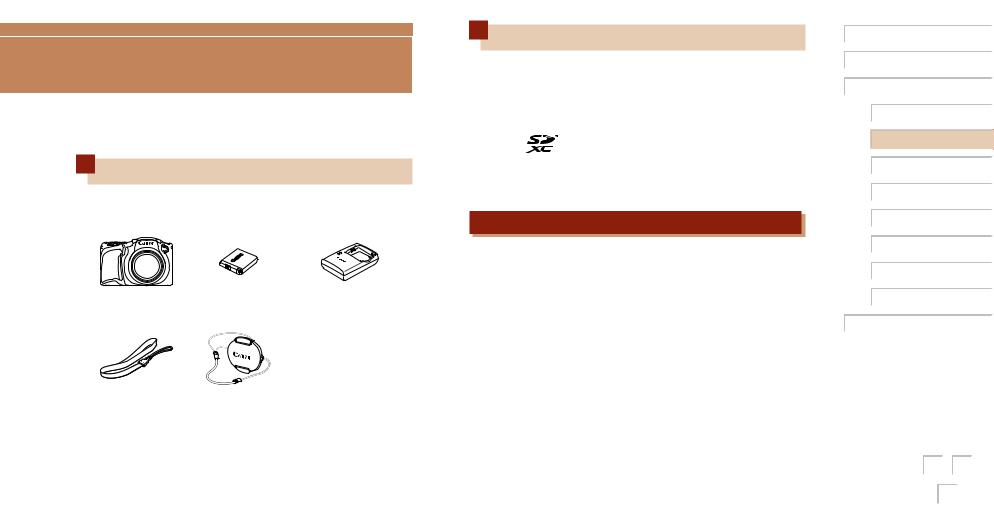
BEFORE USE
Initial Information
Package Contents
Before use, make sure the following items are included in the package. If anything is missing, contact your camera retailer.
Camera |
Battery Pack |
Battery Charger |
|
NB-11LH* |
CB-2LF/CB-2LFE |
||
|
Wrist Strap
Lens Cap (with cord)
*Do not peel off the battery pack label.
●Printed matter is also included.
●A memory card is not included (=2).
Compatible Memory Cards
The following memory cards (sold separately) can be used, regardless of capacity.
●SD memory cards*
●SDHC memory cards*
● SDXC |
cards* |
|
|
|
|
● Eye-Fi cards
*Cards conforming to SD standards. However, not all memory cards have been veriied to work with the camera.
About Eye-Fi Cards
This product is not guaranteed to support Eye-Fi card functions (including wireless transfer). In case of an issue with an Eye-Fi card, please check with the card manufacturer.
Also note that an approval is required to use Eye-Fi cards in many countries or regions. Without approval, use of the card is not permitted. If it is unclear whether the card has been approved for use in the area, please check with the card manufacturer.
2

Preliminary Notes and Legal
Information
●Take and review some test shots initially to make sure the images
were recorded correctly. Please note that Canon Inc., its subsidiaries and afiliates, and its distributors are not liable for any consequential damages arising from any malfunction of a camera or accessory, including memory cards, that result in the failure of an image to be recorded or to be recorded in a way that is machine readable.
●Images recorded by the camera shall be for personal use. Refrain from unauthorized recording that infringes on copyright law, and note that even for personal use, photography may contravene copyright or other legal rights at some performances or exhibitions, or in some commercial settings.
●For information on camera warranty or Canon Customer Support, please refer to the warranty information provided with your camera User Manual Kit.
●Although the LCD monitor is produced under extremely high-precision
manufacturing conditions and more than 99.99% of the pixels meet design speciications, in rare cases some pixels may be defective or may appear as red or black dots. This does not indicate camera damage or affect recorded images.
●The LCD monitor may be covered with a thin plastic ilm for protection against scratches during shipment. If covered, remove the ilm before using the camera.
●When the camera is used over an extended period, it may become warm. This does not indicate damage.
Part Names and Conventions in This
Guide
(1)(2) (3) (4) (5)
(3)
|
|
(6) |
(8) |
(9) |
|
||
|
|
|
|||||
|
|
|
|
|
|
|
|
|
|
|
|
|
|
|
|
|
|
|
|
|
|
|
|
|
|
|
|
|
|
|
|
|
|
|
|
|
|
|
|
|
|
|
|
|
|
|
|
|
|
|
|
|
|
|
|
|
|
|
|
|
|
|
|
|
|
|
|
|
|
|
|
|
|
|
|
|
|
|
|
|
|
|
|
|
|
|
|
(7)
(1) |
Zoom lever |
|
(4) |
ON/OFF button |
|
|
|
|
|
|
|
|
Shooting: |
(telephoto)] / |
(5) |
Flash |
|
|
|
|
|
|
|
|
|
(wide angle)] |
|
|
|
|
|
|
|
||
|
|
(6) |
Lamp |
|
|
|
|
|
|
|
|
|
Playback: |
(magnify)] / |
|
|
|
|
|
|
|
||
|
|
|
|
|
|
|
|
|
|
||
|
[ |
(index)] |
(7) |
Lens |
|
|
|
|
|
|
|
(2) |
Shutter button |
|
(8) |
Tripod socket |
|
|
|
|
|
|
|
(3) |
Strap mount |
|
(9) |
Memory card/battery cover |
|
|
|
|
|
|
|
|
|
|
|
|
|
|
|
|
|
|
|
|
|
|
|
|
|
|
|
|
|
|
|
|
|
|
|
|
|
|
|
|
|
|
|
|
|
|
|
|
|
|
|
|
|
|
|
3

(1) (2) |
(3) |
(6) |
(7) |
(8)
(9)
(10) (11) (12)
(13)
(4) |
(5) |
(14) (15) (16) |
(1)Speaker
(2)Microphone
(3)AV OUT (Audio/video output) / DIGITAL terminal
(4)Screen (LCD monitor)
(5)DC coupler cable port
(6)Indicator
(7)[ (Playback)] button
(8)Movie button
(9) (Auto)] button
(Auto)] button
(10)[ (Exposure compensation)] / Up button
(11)FUNC./SET button
(12)[ (Flash)] / Right button
(13) (Self-timer)] /
(Self-timer)] /  (Single-image erase)] / Down button
(Single-image erase)] / Down button
(14) (Focusing range)] / Left button
(Focusing range)] / Left button
(15) (Display)] button
(Display)] button
(16)] button
●In this guide, icons are used to represent the corresponding camera buttons on which they appear, or which they resemble.
●The following camera buttons and controls are represented by icons. [ ] Up button (10) on back
[ ] Left button (14) on back [ ] Right button (12) on back
[ ] Down button (13) on back
●Shooting modes and on-screen icons and text are indicated in brackets.
● : Important information you should know
: Important information you should know
● : Notes and tips for expert camera use
: Notes and tips for expert camera use
●=xx: Pages with related information (in this example, “xx” represents a page number)
●Instructions in this guide apply to the camera under default settings.
●For convenience, all supported memory cards are simply referred to as the “memory card”.
●The symbols “ Still Images” and “
Still Images” and “ Movies” below titles indicate how the function is used—whether for still images or movies.
Movies” below titles indicate how the function is used—whether for still images or movies.
4

Table of Contents |
|
Before Use |
|
Initial Information.............................................................. |
2 |
Package Contents.................................................................... |
2 |
Compatible Memory Cards....................................................... |
2 |
About Eye-Fi Cards ..................................................................... |
2 |
Preliminary Notes and Legal Information ................................. |
3 |
Part Names and Conventions in This Guide ............................ |
3 |
Common Camera Operations ................................................ |
10 |
Safety Precautions .................................................................. |
11 |
Basic Guide |
|
Basic Operations............................................................. |
14 |
Initial Preparations.................................................................. |
14 |
Attaching Accessories ............................................................... |
14 |
Holding the Camera................................................................... |
15 |
Charging the Battery Pack......................................................... |
15 |
Inserting the Battery Pack and Memory Card............................ |
16 |
Removing the Battery Pack and Memory Card ..................... |
16 |
Setting the Date and Time......................................................... |
17 |
Changing the Date and Time................................................. |
17 |
Display Language...................................................................... |
18 |
Trying the Camera Out........................................................... |
19 |
Shooting (Smart Auto) ............................................................... |
19 |
Viewing...................................................................................... |
20 |
Erasing Images ..................................................................... |
21 |
Advanced Guide |
|
|
1 |
Camera Basics........................................................... |
22 |
|
On/Off..................................................................................... |
22 |
|
Power-Saving Features (Auto Power Down)............................. |
23 |
|
Power Saving in Shooting Mode ........................................... |
23 |
|
Power Saving in Playback Mode........................................... |
23 |
|
Shutter Button ........................................................................ |
23 |
|
Shooting Display Options....................................................... |
24 |
|
Using the FUNC. Menu .......................................................... |
24 |
|
Using the Menu Screen.......................................................... |
25 |
|
Indicator Display..................................................................... |
26 |
|
Clock ...................................................................................... |
27 |
2 |
Auto Mode.................................................................. |
28 |
|
Shooting with Camera-Determined Settings .......................... |
28 |
|
Shooting (Smart Auto) ............................................................... |
28 |
|
Still Images/Movies ............................................................... |
30 |
|
Still Images............................................................................ |
30 |
|
Movies ................................................................................... |
30 |
|
Scene Icons............................................................................... |
31 |
|
Image Stabilization Icons........................................................... |
32 |
|
On-Screen Frames.................................................................... |
32 |
|
Common, Convenient Features ............................................. |
33 |
|
Zooming In Closer on Subjects (Digital Zoom).......................... |
33 |
|
Using the Self-Timer.................................................................. |
33 |
|
Using the Self-Timer to Avoid Camera Shake ....................... |
34 |
|
Customizing the Self-Timer ................................................... |
34 |
|
Adding a Date Stamp ................................................................ |
35 |
|
Continuous Shooting ................................................................. |
35 |
|
Image Customization Features .............................................. |
36 |
|
Changing the Aspect Ratio........................................................ |
36 |
5

|
Changing Image Resolution (Size)............................................ |
37 |
|
Guidelines for Choosing Resolution Based on Paper Size |
|
|
(for 4:3 Images) ..................................................................... |
37 |
|
Red-Eye Correction................................................................... |
37 |
|
Changing Movie Image Quality ................................................. |
38 |
|
Helpful Shooting Features...................................................... |
38 |
|
Displaying Grid Lines................................................................. |
38 |
|
Magnifying the Area in Focus .................................................... |
39 |
|
Checking for Closed Eyes ......................................................... |
39 |
|
Customizing Camera Operation............................................. |
40 |
|
Deactivating the AF-Assist Beam .............................................. |
40 |
|
Deactivating the Red-Eye Reduction Lamp............................... |
40 |
|
Changing the Image Display Style after Shots.......................... |
40 |
|
Changing the Image Display Period after Shots ................... |
40 |
|
Changing the Screen Displayed after Shots ......................... |
41 |
3 |
Other Shooting Modes.............................................. |
42 |
|
Brightness / Color Customization (Live View Control)............ |
42 |
|
SpeciicScenes ...................................................................... |
43 |
|
Applying Special Effects......................................................... |
44 |
|
Shooting with a Fish-Eye Lens Effect (Fish-Eye Effect) ............ |
44 |
|
Shots Resembling Miniature Models (Miniature Effect)............. |
45 |
|
Playback Speed and Estimated Playback Time |
|
|
(for One-Minute Clips) ........................................................... |
45 |
|
Shooting with a Toy Camera Effect (Toy Camera Effect)........... |
46 |
|
Shooting in Monochrome........................................................... |
46 |
|
Special Modes for Other Purposes ........................................ |
47 |
|
Using the Face Self-Timer......................................................... |
47 |
|
Shooting Long Exposures (Long Shutter) ................................. |
47 |
4 |
P Mode........................................................................ |
49 |
|
Shooting in Program AE ([P] Mode) ....................................... |
49 |
|
Image Brightness (Exposure)................................................. |
50 |
Adjusting Image Brightness (Exposure Compensation)............ |
50 |
Locking Image Brightness / Exposure (AE Lock) ...................... |
50 |
Changing the Metering Method ................................................. |
51 |
Changing the ISO Speed........................................................... |
51 |
Correcting Image Brightness (i-Contrast).................................. |
52 |
Image Colors.......................................................................... |
52 |
Adjusting White Balance............................................................ |
52 |
Custom White Balance.......................................................... |
53 |
Changing Image Color Tones (My Colors) ................................ |
53 |
Custom Color......................................................................... |
54 |
Shooting Range and Focusing............................................... |
54 |
Shooting Close-Ups (Macro) ..................................................... |
54 |
Shooting Distant Subjects (Ininity) ............................................ |
55 |
Digital Tele-Converter................................................................ |
55 |
Changing the AF Frame Mode .................................................. |
55 |
Center.................................................................................... |
55 |
Face AiAF.............................................................................. |
56 |
Choosing Subjects to Focus On (Tracking AF) ..................... |
56 |
Shooting with Servo AF ......................................................... |
57 |
Changing the Focus Setting ...................................................... |
57 |
Shooting with the AF Lock......................................................... |
58 |
Flash....................................................................................... |
58 |
Changing the Flash Mode ......................................................... |
58 |
Auto ....................................................................................... |
58 |
On.......................................................................................... |
58 |
Slow Synchro ........................................................................ |
58 |
Off.......................................................................................... |
59 |
Shooting with the FE Lock......................................................... |
59 |
Other Settings ........................................................................ |
59 |
Changing the Compression Ratio (Image Quality).................... |
59 |
6

Changing the IS Mode Settings................................................. |
60 |
Shooting Movies with Subjects at the Same Size Shown |
|
before Shooting ..................................................................... |
60 |
5 Playback Mode .......................................................... |
61 |
Viewing................................................................................... |
61 |
Switching Display Modes........................................................... |
62 |
Overexposure Warning (for Image Highlights) ...................... |
62 |
Histogram .............................................................................. |
63 |
Browsing and Filtering Images............................................... |
63 |
Navigating through Images in an Index..................................... |
63 |
FindingImagesMatchingSpeciiedConditions ......................... |
64 |
Image Viewing Options .......................................................... |
65 |
Magnifying Images .................................................................... |
65 |
Viewing Slideshows................................................................... |
65 |
Changing Slideshow Settings................................................ |
66 |
AutoPlaybackofRelatedImages(SmartShufle) .................... |
66 |
Protecting Images .................................................................. |
67 |
Using the Menu ......................................................................... |
67 |
Choosing Images Individually.................................................... |
67 |
Selecting a Range ..................................................................... |
68 |
Protecting All Images at Once ................................................... |
69 |
Clearing All Protection at Once ............................................. |
69 |
Erasing Images ...................................................................... |
69 |
Erasing Multiple Images at Once............................................... |
69 |
Choosing a Selection Method ............................................... |
69 |
Choosing Images Individually................................................ |
70 |
Selecting a Range ................................................................. |
70 |
Specifying All Images at Once............................................... |
70 |
Rotating Images ..................................................................... |
71 |
Using the Menu ......................................................................... |
71 |
Deactivating Auto Rotation ........................................................ |
71 |
Tagging Images as Favorites ................................................. |
72 |
Using the Menu ......................................................................... |
72 |
Editing Still Images................................................................. |
73 |
Resizing Images........................................................................ |
73 |
Cropping.................................................................................... |
73 |
Changing Image Color Tones (My Colors) ................................ |
74 |
Correcting Image Brightness (i-Contrast).................................. |
75 |
Correcting Red-Eye................................................................... |
75 |
Editing Movies........................................................................ |
76 |
6 Setting Menu.............................................................. |
77 |
Adjusting Basic Camera Functions ........................................ |
77 |
Silencing Camera Operations.................................................... |
77 |
Adjusting the Volume................................................................. |
77 |
Hiding Hints and Tips................................................................. |
78 |
Date and Time ........................................................................... |
78 |
World Clock ............................................................................... |
78 |
Lens Retraction Timing.............................................................. |
79 |
Using Eco Mode ........................................................................ |
79 |
Power-Saving Adjustment ......................................................... |
79 |
Screen Brightness ..................................................................... |
80 |
Hiding the Start-Up Screen........................................................ |
80 |
Formatting Memory Cards......................................................... |
80 |
Low-Level Formatting............................................................ |
81 |
File Numbering .......................................................................... |
81 |
Date-Based Image Storage....................................................... |
82 |
CheckingCertiicationLogos ..................................................... |
82 |
Display Language...................................................................... |
82 |
Adjusting Other Settings............................................................ |
82 |
Restoring Defaults..................................................................... |
83 |
7

7 Accessories ............................................................... |
84 |
System Map ........................................................................... |
84 |
Optional Accessories.............................................................. |
85 |
Power Supplies.......................................................................... |
85 |
Flash Unit .................................................................................. |
86 |
Other Accessories ..................................................................... |
86 |
Printer........................................................................................ |
86 |
Using Optional Accessories.................................................... |
87 |
Playback on a TV ...................................................................... |
87 |
Powering the Camera with Household Power........................... |
87 |
Using the Software................................................................. |
89 |
Software .................................................................................... |
89 |
Software Instruction Manual.................................................. |
89 |
Checking Your Computer Environment ..................................... |
89 |
Installing the Software ............................................................... |
90 |
Saving Images to a Computer................................................... |
90 |
Printing Images ...................................................................... |
92 |
Easy Print .................................................................................. |
92 |
Coniguring Print Settings .......................................................... |
93 |
Cropping Images before Printing........................................... |
93 |
Choosing Paper Size and Layout before Printing ................. |
94 |
Available Layout Options....................................................... |
94 |
Printing ID Photos ................................................................. |
94 |
Printing Movie Scenes............................................................... |
95 |
Movie Printing Options .......................................................... |
95 |
Adding Images to the Print List (DPOF) .................................... |
95 |
Coniguring Print Settings ...................................................... |
95 |
Setting Up Printing for Individual Images .............................. |
96 |
Setting Up Printing for a Range of Images............................ |
97 |
Setting Up Printing for All Images.......................................... |
97 |
Clearing All Images from the Print List .................................. |
97 |
Printing Images Added to the Print List (DPOF).................... |
97 |
Adding Images to a Photobook ................................................. |
97 |
Choosing a Selection Method ............................................... |
97 |
Adding Images Individually.................................................... |
98 |
Adding All Images to a Photobook ........................................ |
98 |
Removing All Images from a Photobook ............................... |
98 |
Using an Eye-Fi Card............................................................. |
99 |
Checking Connection Information ............................................. |
99 |
Disabling Eye-Fi Transfer ........................................................ |
100 |
8 Appendix.................................................................. |
101 |
Troubleshooting.................................................................... |
101 |
On-Screen Messages........................................................... |
104 |
On-Screen Information......................................................... |
105 |
Shooting (Information Display) ................................................ |
105 |
Battery Level ....................................................................... |
106 |
Playback (Detailed Information Display).................................. |
106 |
Summary of Movie Control Panel........................................ |
107 |
Functions and Menu Tables ................................................. |
107 |
Functions Available in Each Shooting Mode ........................... |
107 |
FUNC. Menu............................................................................ |
108 |
Shooting Tab............................................................................ |
110 |
Set Up Tab............................................................................... |
112 |
Playback Tab ........................................................................... |
113 |
Print Tab .................................................................................. |
113 |
Playback Mode FUNC. Menu.................................................. |
113 |
Handling Precautions ............................................................ |
114 |
Speciications ........................................................................ |
114 |
Camera Speciications ............................................................. |
114 |
DigitalZoomFocalLength(35mmilmequivalent) ............. |
115 |
Number of Shots/Recording Time, Playback Time.............. |
115 |
Number of Shots per Memory Card .................................... |
115 |
Recording Time per Memory Card ...................................... |
116 |
8

Flash Range ........................................................................ |
116 |
Shooting Range................................................................... |
116 |
Continuous Shooting Speed................................................ |
116 |
Shutter Speed ..................................................................... |
116 |
Aperture............................................................................... |
116 |
Battery Pack NB-11LH......................................................... |
117 |
Battery Charger CB-2LF/CB-2LFE...................................... |
117 |
Index...................................................................................... |
118 |
Trademarks and Licensing .................................................. |
120 |
Disclaimer............................................................................ |
120 |
9
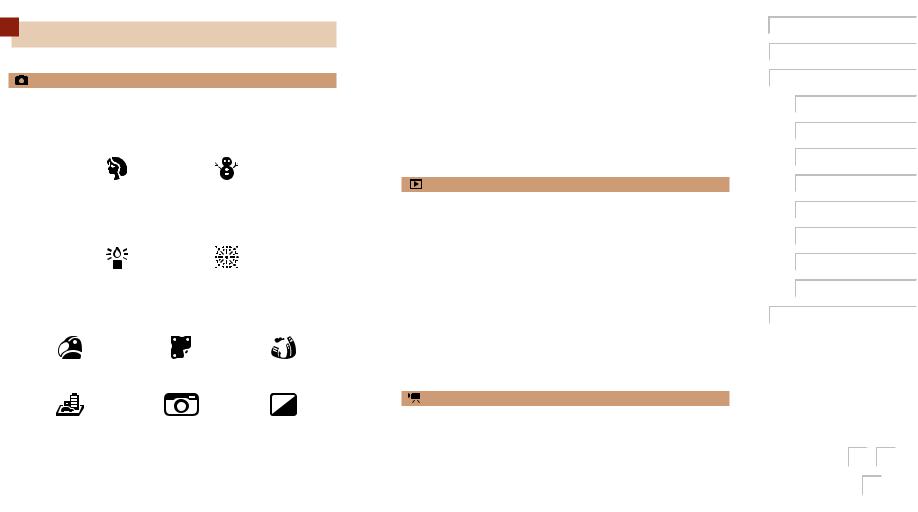
Common Camera Operations
Shoot
●Use camera-determined settings (Auto Mode) - =28
Shooting people well
Portraits |
Against Snow |
(=43) |
(=43) |
Matching speciic scenes
Low Light |
Fireworks |
(=43) |
(=43) |
Applying special effects
Vivid Colors |
Poster Effect |
Fish-Eye Effect |
Miniature Effect |
Toy Camera Effect |
Monochrome |
(=45) |
(=46) |
(=46) |
●While adjusting image settings (Live View Control)
-=42
●Focus on faces
-=28, =43, =56
●Without using the lash (Flash Off)
-=28
●Include yourself in the shot (Self-Timer)
-=33, =47
●Add a date stamp
-=35
View
●View images (Playback Mode)
-=61
●Automatic playback (Slideshow)
-=65
●On a TV
-=87
●On a computer
-=89
●Browse through images quickly
-=63
●Erase images
-=69
Shoot/View Movies
●Shoot movies
-=28
●View movies (Playback Mode)
-=61
10

●Print pictures
-=92
Save
●Save images to a computer
-=90
Safety Precautions
●Before using the product, ensure that you read the safety precautions described below. Always ensure that the product is used correctly.
●The safety precautions noted here are intended to prevent you and other persons from being injured or incurring property damage.
●Be sure to also check the guides included with any separately sold accessories you use.

 Warning Denotes the possibility of serious injury or death.
Warning Denotes the possibility of serious injury or death.
● Do not trigger the lash in close proximity to people’s eyes. Exposure to the intense light produced by the lash could damage
eyesight. In particular, remain at least 1 meter (3.3 feet) away from infants when using the lash.
● Store this equipment out of the reach of children and infants.
A strap wound around a child’s neck may result in asphyxiation.
If your product uses a power cord, mistakenly winding the cord around a child’s neck may result in asphyxiation.
● Use only recommended power sources.
●Do not disassemble, alter, or apply heat to the product.
●Do not peel off the label, if the battery pack has one.
●Avoid dropping or subjecting the product to severe impacts.
●Do not touch the interior of the product if it is broken, such as when dropped.
●Stop using the product immediately if it emits smoke or a strange smell, or otherwise behaves abnormally.
●Do not use organic solvents such as alcohol, benzine, or thinner to
clean the product.
11

● Avoid contact with liquid, and do not allow liquid or foreign objects
inside.
This could result in electrical shock or ire.
If the product gets wet, or if liquid or foreign objects get inside, remove the battery pack/batteries or unplug immediately.
●Do not look through the viewinder (if your model has one) at intense light sources, such as the sun on a clear day or an intense artiicial light source.
This could damage your eyesight.
● Do not touch the product during thunderstorms if it is plugged in.
This could result in electrical shock or ire. Immediately stop using the product and distance yourself from it.
●Use only the recommended battery pack/batteries.
●Do not place the battery pack/batteries near or in direct lame.
This may cause the battery pack/batteries to explode or leak, resulting in electrical shock, ire, or injuries. If leaking battery electrolyte comes into contact with eyes, mouth, skin, or clothing, immediately lush with water.
●If the product uses a battery charger, note the following precautions.
-Remove the plug periodically and, using a dry cloth, wipe away any dust and dirt that has collected on the plug, the exterior of the power outlet, and the surrounding area.
-Do not insert or remove the plug with wet hands.
-Do not use the equipment in a manner that exceeds the rated capacity of the electrical outlet or wiring accessories. Do not use if the plug is damaged or not fully inserted in the outlet.
-Do not allow dust or metal objects (such as pins or keys) to contact the terminals or plug.
-Do not cut, damage, alter, or place heavy items on the power cord, if your product uses one.
This could result in electrical shock or ire.
● Turn the camera off in places where camera use is prohibited.
The electromagnetic waves emitted by the camera may interfere with the operation of electronic instruments and other devices. Exercise adequate caution when using the product in places where use of electronic devices is restricted, such as inside airplanes and medical facilities.
●Do not allow the camera to maintain contact with skin for extended periods.
Even if the camera does not feel hot, this may cause low-temperature burns, manifested in redness of the skin or blistering. Use a tripod in hot places, or if you have poor circulation or insensitive skin.
 Caution Denotes the possibility of injury.
Caution Denotes the possibility of injury.
●When carrying the product by the strap, be careful not to bang it, subject it to strong impacts or shocks, or let it get caught on other objects.
●Be careful not to bump or push strongly on the lens.
This could lead to injury or damage the camera.
● Be careful not to subject the screen to strong impacts.
If the screen cracks, injury may result from the broken fragments.
● When using the lash, be careful not to cover it with your ingers or
clothing.
This could result in burns or damage to the lash.
●Avoid using, placing, or storing the product in the following places:
-Places subject to direct sunlight
-Places subject to temperatures above 40 °C (104 °F)
-Humid or dusty places
These could cause leakage, overheating, or an explosion of the battery pack/batteries, resulting in electrical shock, ire, burns, or other injuries. Overheating and damage may result in electrical shock, ire, burns, or
other injuries.
12
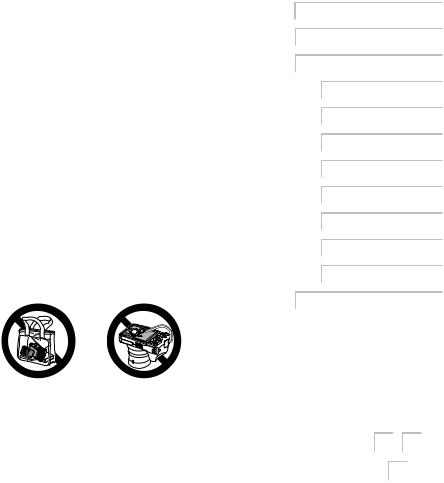
●The slideshow transition effects may cause discomfort when viewed for prolonged periods.
●When using optional lenses, lens ilters, or ilter adapters (if applicable), be sure to attach these accessories irmly.
If the lens accessory becomes loose and falls off, it may crack, and the shards of glass may lead to cuts.
●On products that raise and lower the lash automatically, make sure to avoid pinching your ingers with the lowering lash.
This could result in injury.
Caution |
Denotes the possibility of property damage. |
|
|
● Do not aim the camera at intense light sources, such as the sun on a clear day or an intense artiicial light source.
Doing so may damage the image sensor or other internal components.
●When using the camera on a sandy beach or at a windy location, be careful not to allow dust or sand to enter the camera.
●On products that raise and lower the lash automatically, do not push
the lash down or pry it open.
This may cause the product to malfunction.
●Wipe off any dust, grime, or other foreign matter on the lash with a cotton swab or cloth.
The heat emitted from the lash may cause foreign matter to smoke or the product to malfunction.
●Remove and store the battery pack/batteries when you are not using the product.
Any battery leakage that occurs may cause product damage.
●Before you discard the battery pack/batteries, cover the terminals with tape or other insulators.
Contacting other metal materials may lead to ire or explosions.
●Unplug any battery charger used with the product when not in use. Do not cover with a cloth or other objects when in use.
Leaving the unit plugged in for a long period of time may cause it to overheat and distort, resulting in ire.
● Do not leave any dedicated battery packs near pets.
Pets biting the battery pack could cause leakage, overheating, or explosion, resulting in product damage or ire.
●If your product uses multiple batteries, do not use batteries that have different levels of charge together, and do not use old and new batteries together. Do not insert the batteries with the + and – terminals reversed.
This may cause the product to malfunction.
●Do not sit down with the camera in your pant pocket. Doing so may cause malfunctions or damage the screen.
●When putting the camera in your bag, ensure that hard objects do not
come into contact with the screen. Also close the screen (so that it faces the body), if your product’s screen closes.
●Do not attach any hard objects to the product.
Doing so may cause malfunctions or damage the screen.
13

BASIC GUIDE
Basic Operations
Basic information and instructions, from initial preparations to shooting and playback
Initial Preparations
Prepare for shooting as follows.
Attaching Accessories
Attach the strap.
● Thread the end of the strap through the strap hole (1), and then pull the other end of the strap through the loop on the threaded end (2).
Attach the lens cap.
● Remove the lens cap from the lens momentarily, thread the end of the strap through the strap hole (1), and then pull the lens cap through the loop (2).
● Always remove the lens cap before turning the camera on.
● Keep the lens cap on the lens when the camera is not in use.
 (1) (2)
(1) (2)
14
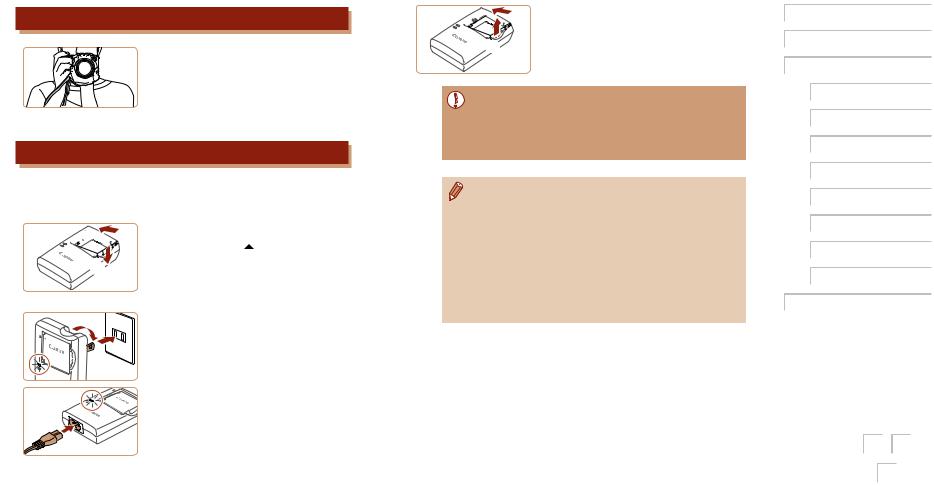
Holding the Camera
Place the strap around your wrist.
When shooting, keep your arms close to your body and hold the camera securely
to prevent it from moving. If you have raised the lash, do not rest your ingers
on it.
Charging the Battery Pack
Before use, charge the battery pack with the included charger. Be sure to charge the battery pack initially, because the camera is not sold with the battery pack charged.
 (1)
(1)
(2)
(1)
(2)
CB-2LF
CB-2LFE
1 Insert the battery pack.
● After aligning the marks on the battery pack and charger, insert the battery pack by pushing it in (1) and down (2).
2 Charge the battery pack.
●CB-2LF: Flip out the plug (1) and plug the charger into a power outlet (2).
●CB-2LFE: Plug the power cord into the charger, then plug the other end into a power outlet.
●The charging lamp turns orange, and charging begins.
●When charging is inished, the lamp turns green.
 (1)
(1)
(2)
3 Remove the battery pack.
●After unplugging the battery charger, remove the battery pack by pushing it in
(1) and up (2).
● To protect the battery pack and keep it in optimal condition, do not charge it continuously for more than 24 hours.
●For battery chargers that use a power cord, do not attach the charger or cord to other objects. Doing so could result in malfunction or damage to the product.
●For details on charging time and the number of shots and recording time possible with a fully charged battery pack, see “Number of Shots/Recording Time, Playback Time” (=115).
●Charged battery packs gradually lose their charge, even when they are not used. Charge the battery pack on (or immediately before) the day of use.
●The charger can be used in areas with 100 – 240 V AC power (50/60 Hz). For power outlets in a different format, use a commercially available adapter for the plug. Never use an electrical transformer designed for traveling, which may damage the battery pack.
15

Inserting the Battery Pack and Memory Card
Insert the included battery pack and a memory card (sold separately). Note that before using a new memory card (or a memory card formatted in another device), you should format the memory card with this camera
(1) (2)
(1)
Open the cover.
●Slide the cover (1) and open it (2).
Insert the battery pack.
●Holding the battery pack with the terminals (1) facing as shown, press the battery lock (2) in the direction of the arrow and insert the battery pack until the lock clicks shut.
●If you insert the battery pack facing the
wrong way, it cannot be locked into the correct position. Always conirm that the battery pack is facing the right way and locks when inserted.
3 Check the card’s write-protect tab and insert the memory card.
●Recording is not possible on memory cards with a write-protect tab when the tab is in the locked position. Slide the tab to the unlocked position.
●Insert the memory card with the label (1) facing as shown until it clicks into place.
●Make sure the memory card is facing the right way when you insert it. Inserting memory cards facing the wrong way may damage the camera.
4 Close the cover.
● Lower the cover (1) and hold it down as you slide it, until it clicks into the closed
 (2) position (2).
(2) position (2).
● For guidelines on how many shots or hours of recording can be saved on one memory card, see “Number of Shots per Memory Card” (=115).
 Removing the Battery Pack and Memory Card
Removing the Battery Pack and Memory Card
Remove the battery pack.
● Open the cover and press the battery lock in the direction of the arrow.
● The battery pack will pop up.
Remove the memory card.
● Push the memory card in until it clicks, and then slowly release it.
● The memory card will pop up.
16

Setting the Date and Time
Set the current date and time correctly as follows if the [Date/Time] screen is displayed when you turn the camera on. Information you specify this way is recorded in image properties when you shoot, and it is used when you manage images by shooting date or print images showing the date.
to shots, if you wish (=35).
Turn the camera on.
● Press the ON/OFF button.
● The [Date/Time] screen is displayed.
2 Set the date and time.
●Press the [ ][ ] buttons to choose an option.
● Press the [ ][ |
] buttons to specify the |
|
date and time. |
|
|
● When inished, press |
] button. |
|
3 Specify your home time zone.
●Press the [ ][ ] buttons to choose your home time zone.
4 Finish |
process. |
● Press |
] button when inished. |
After a conirmation message, the setting screen is no longer displayed.
● To turn off the camera, press the ON/OFF button.
● Unless you set the date, time, and home time zone, the [Date/ Time] screen will be displayed each time you turn the camera on. Specify the correct information.
● To set daylight saving time (1 hour ahead), choose [

 ] in step 2 and then choose [
] in step 2 and then choose [
 ] by pressing the [ ][ ] buttons.
] by pressing the [ ][ ] buttons.
 Changing the Date and Time
Changing the Date and Time
Adjust the date and time as follows.
1 Access the menu screen.
● Press the [ ] button.
] button.
2 Choose [Date/Time].
●Move the zoom lever to choose the [ ] tab.
] tab.
●Press the [ ][
][ ] buttons to choose [Date/Time], and then press the [
] buttons to choose [Date/Time], and then press the [ ] button.
] button.
3 Change the date and time.
● Follow step 2 in “Setting the Date and Time” (=17) to adjust the settings.
● Press the [ ] button to close the menu screen.
] button to close the menu screen.
17
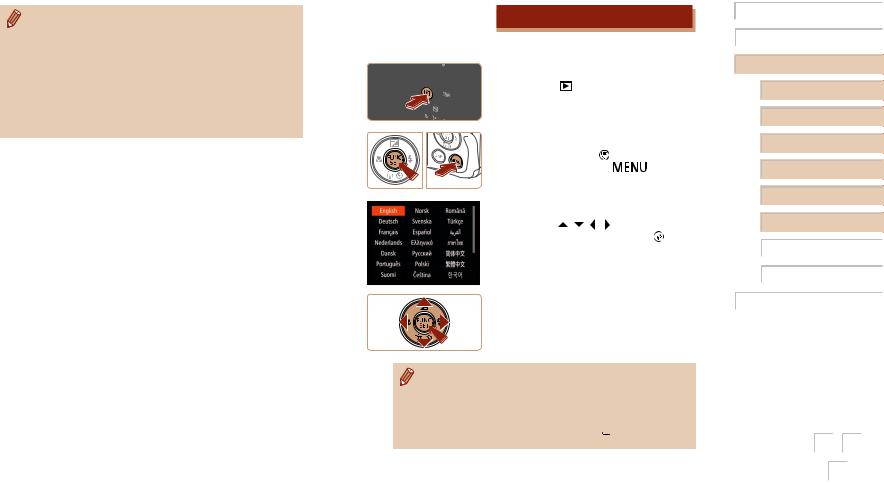
●Date/time settings can be retained for about 3 weeks by the camera’s built-in date/time battery (backup battery) after the
battery pack is removed.
●The date/time battery will be charged in about 4 hours once you insert a charged battery pack or connect the camera to an AC adapter kit (sold separately, =85), even if the camera is left off.
●Once the date/time battery is depleted, the [Date/Time] screen will be displayed when you turn the camera on. Set the correct date and time as described in “Setting the Date and Time” (=17).
Display Language
Change the display language as needed.
1 |
Enter Playback mode. |
|
|
|
|
● Press the [ |
] button. |
|
|
|
|
|
|
|
|||
2 |
Access the |
|
. |
|
|
|
|
|
|||
|
|
|
|||
|
|
|
|||
|
|
|
|||
● Press and hold |
and then |
|
|
||
|
|
||||
|
immediately press |
] button. |
|
|
|
3 |
Set the display language. |
|
|
|
|
|
|
|
|||
|
|
|
|||
|
|
|
|||
● Press the [ |
][ ][ ][ ] buttons |
|
|
||
|
a language, and then press |
] |
|
|
|
|
button. |
|
|
|
|
●Once the display language has been set, the setting screen is no longer displayed.
● The current time is displayed if you wait too long in step 2 after pressing the [ ] button before you press the [
] button before you press the [ ] button. In this case, press the [
] button. In this case, press the [ ] button to dismiss the time display and repeat step 2.
] button to dismiss the time display and repeat step 2.
● You can also change the display language by pressing the
[ ] button and choosing [Language
] button and choosing [Language  ] on the [
] on the [ ] tab.
] tab.
18
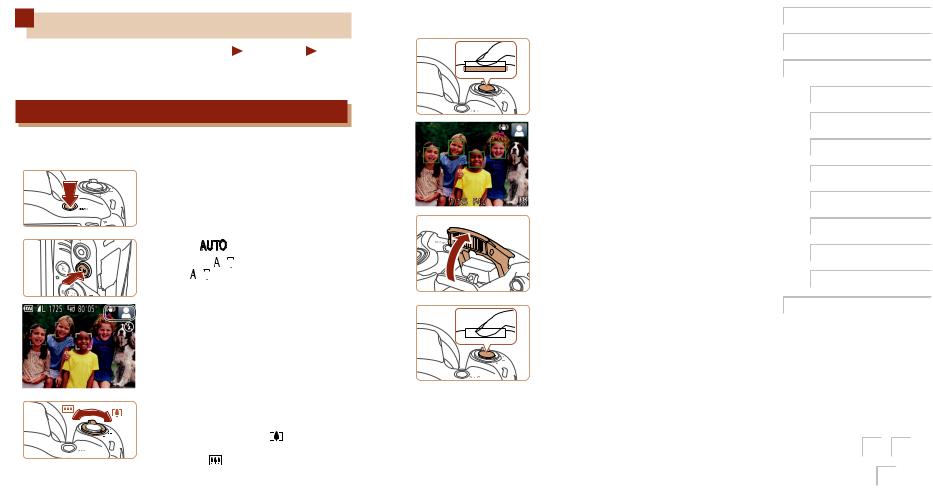
Trying the Camera Out
Still Images |
Movies |
Follow these instructions to turn the camera on, shoot still images or movies, and then view them.
Shooting (Smart Auto)
For fully automatic selection of the optimal settings for speciic scenes, the subject and shooting conditions.
Turn the camera on.
● Press the ON/OFF button.
● The startup screen is displayed.
2 |
] mode. |
●
 ] button several times
] button several times

 ] is displayed.
] is displayed.
● Aim the camera at the subject. The camera will make a slight clicking noise as it determines the scene.
●Icons representing the scene and image stabilization mode are displayed in the upper right of the screen.
●Frames displayed around any detected subjects indicate that they are in focus.
3 Compose the shot.
● To zoom in and |
subject, move |
|
the zoom |
|
] (telephoto), |
and to |
away from the subject, move |
|
it |
] (wide angle). |
|
4 Shoot.
Shooting Still Images
1)Focus.
●Press the shutter button lightly, halfway down. The camera beeps twice after focusing, and AF frames are displayed to indicate image areas in focus.
●If [Raise the lash] is displayed, lift the lash with your inger to prepare it for use. If you prefer not to use the lash, push it down with your inger, into the camera.
2)Shoot.
●Press the shutter button all the way down.
●As the camera shoots, a shutter sound
is played, and in low-light conditions when you have raised the lash, it ires automatically.
●Keep the camera still until the shutter sound ends.
●After displaying your shot, the camera will revert to the shooting screen.
19
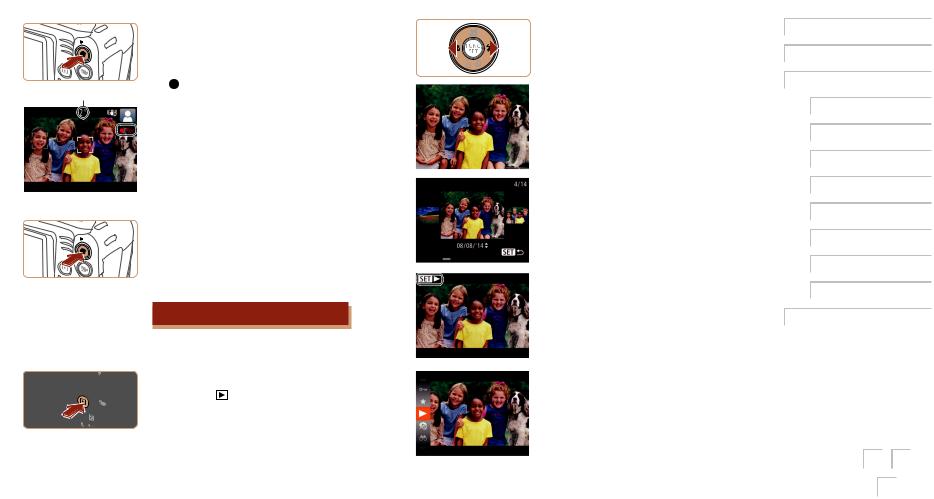
|
Shooting Movies |
|
Start shooting. |
|
● Press the movie button. The camera |
|
beeps once as recording begins, and |
|
Rec] is displayed with the elapsed |
(1) |
time (1). |
● Black bars are displayed on the top and bottom edges of the screen, and the subject is slightly enlarged. The black bars indicate image areas not recorded.
●Frames displayed around any detected faces indicate that they are in focus.
●Once recording begins, take your inger off the movie button.
2) Finish shooting.
● Press the movie button again to stop shooting. The camera beeps twice as recording stops.
Viewing
After shooting images or movies, you can view them on the screen as follows.
1 Enter Playback mode.
● Press the [ ] button.
● Your last shot is displayed.
2 Browse through your images.
●To view the previous image, press the [ ] button. To view the next image, press the [
] button. To view the next image, press the [ ] button.
] button.
●To access this screen (Scroll Display
mode), press and hold the [ ][
][ ] buttons for at least one second. In this mode,
] buttons for at least one second. In this mode,
press the [ ][
][ ] buttons to browse through images.
] buttons to browse through images.
●To return to single-image display, press the [ ] button.
] button.
●Movies are identiied by a [ ] icon. To play movies, go to step 3.
] icon. To play movies, go to step 3.
3 Play movies.
●Press the [ ] button, press the [
] button, press the [ ][
][ ] buttons to choose [
] buttons to choose [ ], and then press the [
], and then press the [ ] button again.
] button again.
●Playback now begins, and after the movie is inished, [ ] is displayed.
] is displayed.
●To adjust the volume, press the [ ][
][ ] buttons.
] buttons.
20

● To switch to Shooting mode from Playback mode, press the shutter button halfway.
 Erasing Images
Erasing Images
You can choose and erase unneeded images one by one. Be careful when erasing images, because they cannot be recovered.
1 Choose an image to erase.
●Press the [ ][
][ ] buttons to choose an image.
] buttons to choose an image.
2 Erase the image.
●Press the [ ] button.
] button.
●After [Erase?] is displayed, press the
[ ][
][ ] buttons to choose [Erase], and then press the [
] buttons to choose [Erase], and then press the [ ] button.
] button.
● The current image is now erased.
● To cancel erasure, press the [ ][
][ ] buttons to choose [Cancel], and then press the [
] buttons to choose [Cancel], and then press the [ ] button.
] button.
● You can choose multiple images to erase at once (=69).
21

ADVANCED GUIDE |
1 |
Camera Basics
Other basic operations and more ways to enjoy your camera, including shooting and playback options
On/Off
Shooting Mode
● Press the ON/OFF button to turn the camera on and prepare for shooting.
● To turn the camera off, press the ON/OFF button again.
Playback Mode
● Press the [ ] button to turn the camera on and view your shots.
● To turn the camera off, press the [ ] button again.
● To switch to Playback mode from Shooting mode, press the [ ] button.
] button.
●To switch to Shooting mode from Playback mode, press the shutter button halfway (=23).
●The lens will be retracted after about one minute once the camera
is in Playback mode. You can turn the camera off when the lens is retracted by pressing the [ ] button.
] button.
22
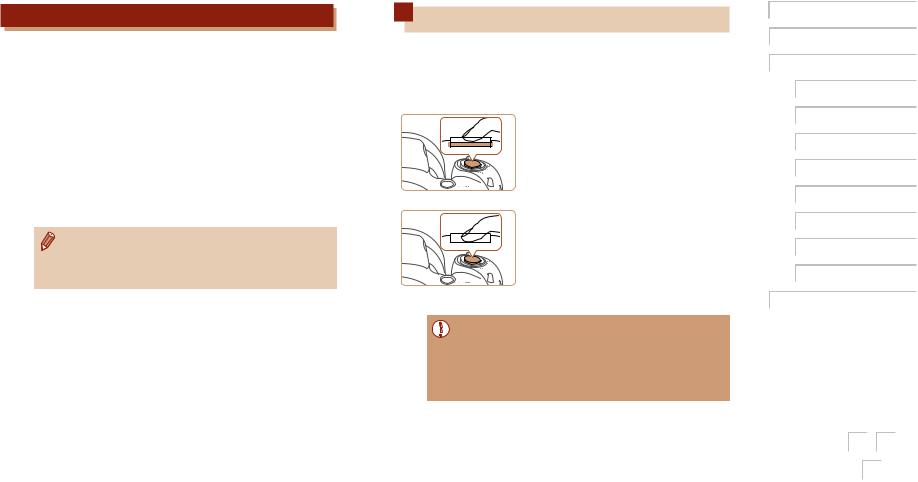
Power-Saving Features (Auto Power Down)
As a way to conserve battery power, the camera automatically deactivates the screen (Display Off) and then turns itself off after a speciic period of
inactivity.
 Power Saving in Shooting Mode
Power Saving in Shooting Mode
The screen is automatically deactivated after about one minute of inactivity. In about two more minutes, the lens is retracted and the camera turns itself off. To activate the screen and prepare for shooting when
the screen is off but the lens is still out, press the shutter button halfway (=23).
 Power Saving in Playback Mode
Power Saving in Playback Mode
The camera turns itself off automatically after about ive minutes of inactivity.
● You can deactivate Auto Power Down and adjust the timing of Display Off, if you prefer (=79).
●Power saving is not active while the camera is connected to a computer (=90).
Shutter Button
To ensure your shots are in focus, always begin by holding the shutter button halfway down, and once the subject is in focus, press the button all the way down to shoot.
In this manual, shutter button operations are described as pressing the down.
Press halfway. (Press lightly to focus.)
● Press the shutter button halfway. The camera beeps twice, and AF frames are displayed around image areas in focus.
Press all the way down. (From the halfway position, press fully to shoot.)
● The camera shoots, as a shutter sound is played.
● Keep the camera still until the shutter sound ends.
● Images may be out of focus if you shoot without initially pressing the shutter button halfway.
●Length of shutter sound playback varies depending on the time required for the shot. It may take longer in some shooting scenes, and images will be blurry if you move the camera (or the subject moves) before the shutter sound ends.
23

Shooting Display Options
Press ] button to view other information on the screen, or to hide the information. For details on the information displayed, see “OnScreen Information” (=105).
Information is displayed
No information is displayed
● Screen brightness is automatically increased by the night view function when you are shooting under low light, making it easier to check how shots are composed. However, on-screen image brightness may not match the brightness of your shots. Note that any on-screen image distortion or jerky subject motion will not affect recorded images.
●For playback display options, see “Switching Display Modes” (=62).
Using the FUNC. Menu
Conigure commonly used functions through the FUNC. menu as follows.
Note that menu items and options vary depending on the shooting mode (=113).
Access |
FUNC. menu. |
|
|
● Press |
] button. |
|
|
|
|
||
2 Choose a menu item. |
|
|
|
|
|
||
|
|
||
|
|
||
|
|
||
● Press the [ |
][ ] buttons to |
|
|
|
|
||
menu item (1), and then press |
] or |
|
|
[ ] button.
●Available options (2) are listed next to menu items, on the right.
(2) |
● Depending on the menu item, functions |
|
(1) |
can be speciied simply by pressing the |
|
|
] or [ ] button, or another screen is |
|
|
displayed for coniguring the function. |
|
|
3 Choose an option. |
|
|
● Press the [ ][ ] buttons to choose an |
|
|
option. |
|
|
● Options labeled with |
] |
|
be conigured by pressing |
] |
button.
●To return to the menu items, press the [ ] button.
24

4 Finish the setup process.
● Press the [ ] button.
] button.
● The screen before you pressed the
[ ] button in step 1 is displayed again, showing the option you conigured.
] button in step 1 is displayed again, showing the option you conigured.
● To undo any accidental setting changes, you can restore the camera’s default settings (=83).
Using the Menu Screen
Conigure a variety of camera functions through the menu screen as follows. Menu items are grouped by purpose on tabs, such as shooting
], playback [ ], and so on. Note that available menu items vary shooting or playback mode (=110 – =113).
Access screen.
● Press |
] button. |
|
|
|
|
2 Choose a tab.
● Move the zoom lever to choose a tab.
● After you have pressed the [ ][ ] buttons to choose a tab initially, you can switch between tabs by pressing the
[ ][ ] buttons.
3 Choose a menu item.
● Press the [ |
][ ] buttons to choose a |
|
|
|
|
|
menu item. |
|
|
|
|
|
|
● For menu |
options not shown, |
|
|
|
|
|
irst press |
] or [ ] button to switch |
|
|
|
|
|
screens, and then press the [ ][ ] |
|
|
|
|
|
|
buttons to select the menu item. |
|
|
|
|
|
|
● To |
previous screen, press |
|
|
|
|
|
|
|
|
|
|
||
|
] button. |
|
|
|
|
|
|
|
|
|
|
|
|
|
|
|
|
|
|
|
25

4 Choose an option.
● Press the [ ][
][ ] buttons to choose an option.
] buttons to choose an option.
5 Finish the setup process.
●Press the [ ] button to return to the screen displayed before you pressed the
] button to return to the screen displayed before you pressed the
[ ] button in step 1.
] button in step 1.
●To undo any accidental setting changes, you can restore the camera’s default settings (=83).
Indicator Display
The indicator on the back of the camera (=3) lights up or blinks depending on the camera status.
|
|
|
|
On |
Connected to a computer (=90), or display |
|
off (=23, =79) |
|
|
|
|
|
Blinking |
Starting up, recording/reading/transmitting |
|
images, or shooting long exposures (=47) |
|
Color |
Indicator |
Camera Status |
|
Status |
|
Green |
|
|
● When the indicator blinks green, never turn the camera off, open the memory card/battery cover, or shake or jolt the camera, which may corrupt images or damage the camera or memory card.
26

Clock
You can check the current time.
● Press and hold |
] button. |
|
|
|
|
●The current time appears.
●If you hold the camera vertically while using the clock function, it will switch to
vertical display. Press the [ ][ ] buttons
to change |
display color. |
|
|
||
● Press |
] button again to cancel the |
|
clock display.
● When the camera is off, press and hold the [ ] button, then press the ON/OFF button to display the clock.
] button, then press the ON/OFF button to display the clock.
27

2
Auto Mode
Convenient mode for easy shots with greater control over shooting
Shooting with Camera-Determined
Settings
For fully automatic selection of the optimal settings for speciic scenes, simply let the camera determine the subject and shooting conditions.
Shooting (Smart Auto)
Still Images |
Movies |
|
|
|
|
Turn the camera on.
● Press the ON/OFF button.
● The startup screen is displayed.
2 |
] mode. |
●
 ] button several times
] button several times

 ] is displayed.
] is displayed.
● Aim the camera at the subject. The camera will make a slight clicking noise as it determines the scene.
●Icons representing the scene and image
stabilization mode are displayed in the upper right of the screen (=31, =32).
●Frames displayed around any detected subjects indicate that they are in focus.
28
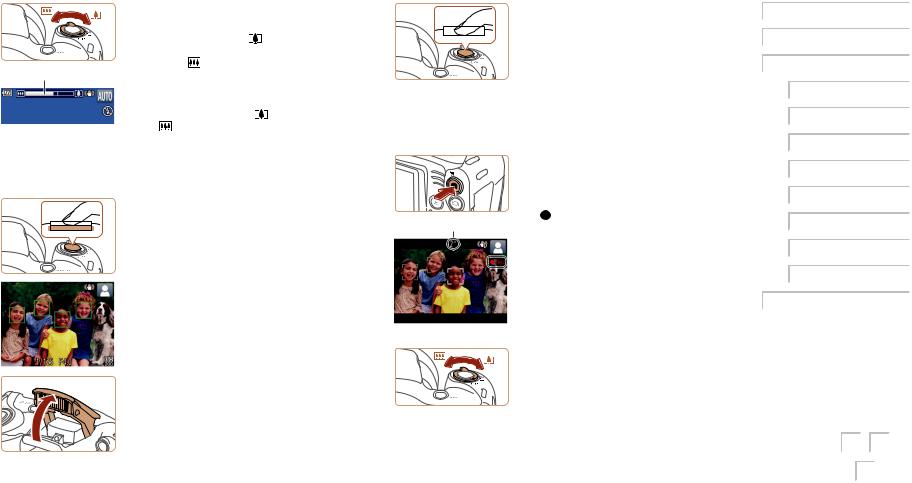
3 Compose the shot. |
|
2) |
Shoot. |
||
● To zoom in and enlarge the subject, move |
|
● Press the shutter button all the way down. |
|||
|
the zoom lever toward [ |
] (telephoto), |
|
● As the camera shoots, a shutter sound |
|
|
and to zoom away from the subject, move |
|
|||
|
|
is played, and in low-light conditions |
|||
|
it toward [ ] (wide angle). (A zoom |
|
|||
|
|
when you have raised the lash, it ires |
|||
(1) |
bar (1) showing the zoom position is |
|
|||
|
automatically. |
||||
|
displayed.) |
|
|
||
|
|
|
● Keep the camera still until the shutter |
||
● To zoom in or out quickly, move the zoom |
|
||||
|
sound ends. |
||||
|
lever all the way toward [ |
] (telephoto) |
|
||
|
|
● After displaying your shot, the camera will |
|||
|
or [ ] (wide angle), and to zoom in |
|
|||
|
|
revert to the shooting screen. |
|||
|
or out slowly, move it just a little in the |
|
|||
|
|
|
|||
|
desired direction. |
|
Shooting Movies |
||
|
|
|
|||
4 |
Shoot. |
|
1) |
Start shooting. |
|
|
|
|
|||
Shooting Still Images |
|
|
● Press the movie button. The camera |
||
1) |
Focus. |
|
|
beeps once as recording begins, and |
|
● Press the shutter button halfway. The |
|
[ Rec] is displayed with the elapsed |
|||
(1) |
time (1). |
||||
|
camera beeps twice after focusing, and |
||||
|
|
● Black bars are displayed on the top and |
|||
|
AF frames are displayed to indicate |
|
|||
|
image areas in focus. |
|
|
bottom edges of the screen, and the |
|
● Several AF frames are displayed when |
|
subject is slightly enlarged. The black |
|||
|
bars indicate image areas not recorded. |
||||
|
multiple areas are in focus. |
|
|||
|
|
● Frames displayed around any detected |
|||
|
|
|
|
||
|
|
|
|
faces indicate that they are in focus. |
|
|
|
|
|
● Once recording begins, take your inger |
|
|
|
|
|
off the movie button. |
|
|
|
|
2) Resize the subject and recompose |
||
● If [Raise the lash] is displayed, lift the |
|
the shot as needed. |
|||
|
● To resize the subject, repeat the |
||||
|
lash with your inger to prepare it for use. |
|
|||
|
|
operations in step 3. |
|||
|
If you prefer not to use the lash, push it |
|
|||
|
|
However, note that the sound of camera |
|||
|
down with your inger, into the camera. |
|
|||
|
|
operations will be recorded. Note that |
|||
|
|
|
|
||
|
|
|
|
movies shot at zoom factors shown in |
|
|
|
|
|
blue will look grainy. |
|
|
|
|
|
● When you recompose shots, the |
|
|
|
|
|
focus, brightness, and colors will be |
|
|
|
|
|
automatically adjusted. |
|
29

3) Finish shooting.
● Press the movie button again to stop shooting. The camera beeps twice as recording stops.
● Recording will stop automatically when the memory card becomes full.
 Still Images/Movies
Still Images/Movies
|
● If the camera is turned on while |
] button is held down, |
|
|
the camera |
no longer sound. To activate sounds again, press |
|
|
|
] button and choose [Mute] on |
] tab, and then |
|
press the [ |
][ ] buttons to choose [Off]. |
|
|
|
|
|
Still Images |
|
|
|
|
● A blinking |
] icon warns that images are more likely to be |
|
blurred by camera shake. In this case, mount the camera on a tripod or take other measures to keep it still.
●If your shots are dark despite the lash iring, move closer to the subject. For details on the lash range, see “Flash Range”
(=116).
●The subject may be too close if the camera only beeps once when you press the shutter button halfway. For details on the focusing range (shooting range), see “Shooting Range” (=116).
●To reduce red-eye and to assist in focusing, the lamp may be activated when shooting in low-light conditions.
●A blinking [ ] icon displayed when you attempt to shoot indicates that shooting is not possible until the lash has inished recharging. Shooting can resume as soon as the lash is ready,
so either press the shutter button all the way down and wait, or release it and press it again.
●Although you can shoot again before the shooting screen is displayed, your previous shot may determine the focus, brightness, and colors used.
● You can change how long images are displayed after shots (=40).
 Movies
Movies
● Before shooting a movie, lower the lash with your inger. Be
careful not to touch the microphone (1) when shooting a movie.
Leaving the lash raised, or blocking the microphone may prevent
audio from being recorded or may cause the recording to sound mufled.
(1)
●Avoid touching camera controls other than the movie button when shooting movies, because sounds made by the camera will be recorded.
●Once movie recording begins, the image display area changes and subjects are enlarged to allow for correction of signiicant
camera shake. To shoot subjects at the same size shown before shooting, adjust the image stabilization setting (=60).
● Audio recording is monaural.
30
